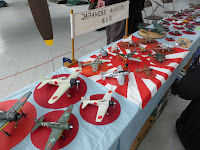The April 1958 issue of “MARU” magazine featured an interview, more like a free discussion, of four Kawasaki designers.
1. Doi Takeo
2. Kitano Jun, Kawasaki Designer
3. Imachi Isamu, Kawasaki Research Department
4. Sakai Iori, IJAAF Headquarters Research Department
The title of the piece was “The background of Toryu Development” and here are some extracts.
Doi: The “Toryu” didn’t start as a night fighter but as a twin seat, heavy fighter.
Maru: What was the aim?
Imachi: Before we start working on the design of the “Toryu”, there was the Ki-38. That was still an idea.
Doi: This assignment was given in December 1937.
Maru: From the Army?
Imachi: The concept behind the heavy fighter changed from the time we started with the Ki-38. The bombers became faster, their service ceiling too became higher. Normal fighters could do combat against other fighters but gradually it became impossible for them to fight against bombers. So, the concept of heavy fighter was born. But there was still no strategic concept and various ideas were created. One of these test ideas for a heavy fighter was the Ki-38. The basic proposal was to design a heavy fighter capable of doing what the single-seat fighters couldn’t, like having extra range, high speed and exceptional horse power. That’s how the concept of twin-seat fighter was born. Even though we were not sure if the concept would work, other countries started building prototypes. In any case, in Kawasaki, we wanted to test research the concept. The Army was not yet sure what they wanted to do until they gave the order for the Ki-45. Until that time Kawasaki had built only aircraft with water-cooled engines. Around that time the NACA cowling for air-cooled engines came about, bringing the performance of this type of engines on a par with the liquid-cooled ones. Maintenance for air-cooled engines was also easier and Kawasaki gave it a try with such engines. Furthermore Kawasaki had experience only with single-engine designs; no experience with twin-engine aircraft. But a little later the Ki-48 was also built.
Around that time, retractable landing gear was common in overseas aircraft designs but not in Japan. So, we decided to give it a try. We knew that the necessary oil pressure system had been developed in the US but we were not sure if it could be made in Japan. So, we started by putting to the test our own ideas. In the beginning it was a manual system but was a failure.
Maru: So the landing gear retracted by hand?
Doi: Soon after take-off we turned the handle by hand like crazy...
Imachi: We installed heavy armament on the heavy fighter. Originally there were no machine cannon designs available to install so we used a design for tanks. But it was way too heavy and was difficult to install.
Doi: The damn thing was more than 130kg!
Imachi: Another novelty was the rear machine gun position. Until that time the reconnaissance aircraft had a rear machine gun but the gunner had to stand up and use their body to swing it, causing excessive wind resistance. So, considering we were aiming for a high speed aircraft we decided to build something new. That was also another new easy-to-use plan of ours. All these little things were incorporated in the new Ki-45 “Toryu” design. In Kasawaki we didn’t built it with mass production in mind but more to test various ideas.
We installed Nakajima Ha-20 engines. That engine was of small size with fairly satisfactory performance. When we were building the “Toryu” prototype there was no available engine yet. Flight tests are more about the engine so we couldn’t exactly do the kind of tests we wanted.




















































